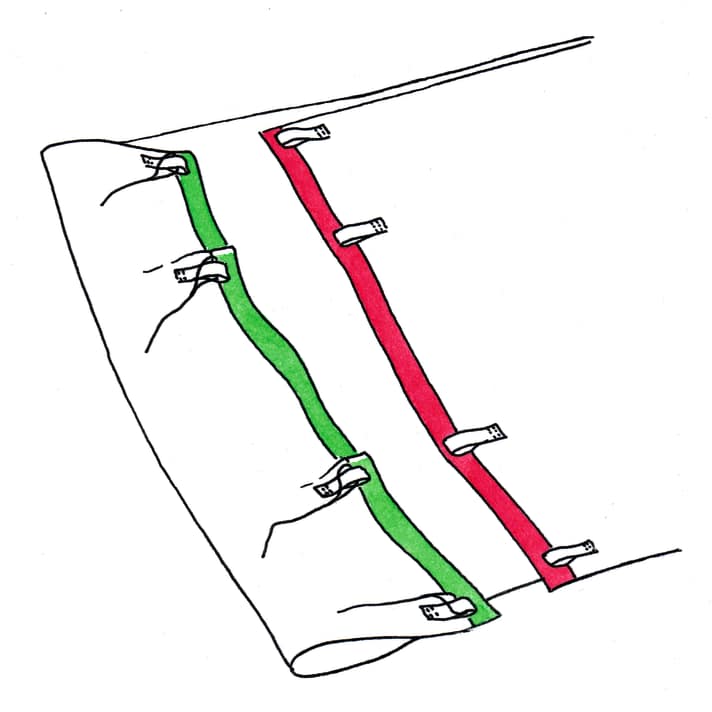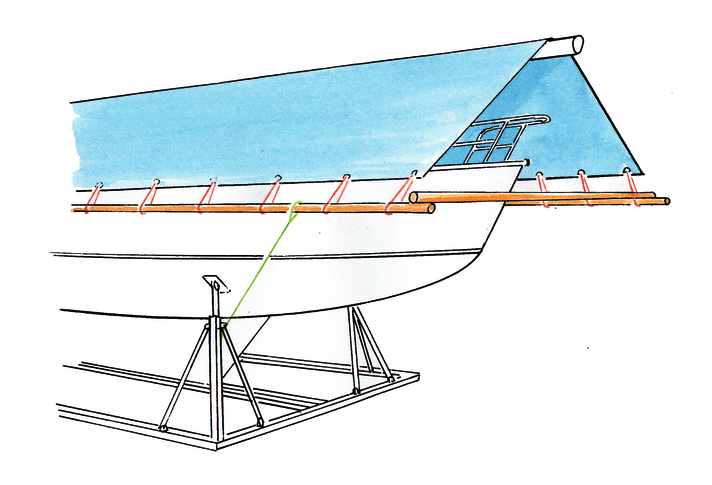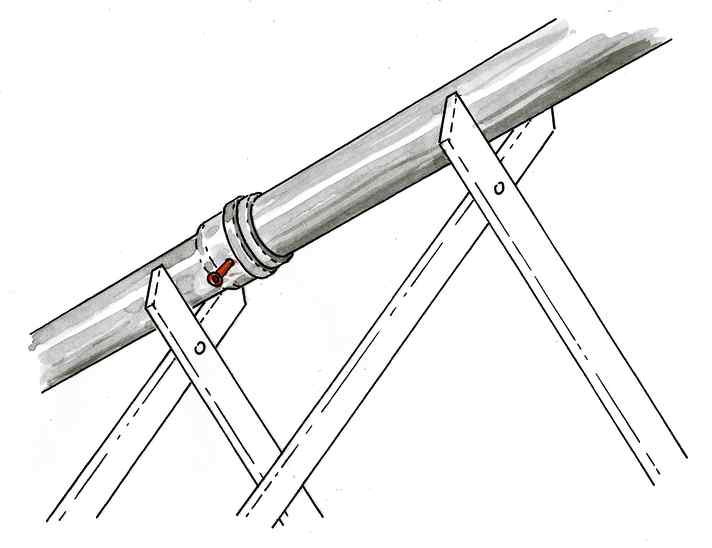





- Winter Lifehack 1: The colour marking shows how the tarpaulin belongs over the boat
- Winter Lifehack 2: Perfectly covered
- Winter Lifehack 3: Screwed on so that the tarpaulin holds
- Winter Lifehack 4: Better ventilation with cross strut
- Winter Lifehack 5: Roof construction made of PVC pipe
- Winter Lifehack 6: Beautiful stripe
- Winter Lifehack 7: Favourable spacers
- Winter Lifehack 8: Paint pot with brush holder
- Winter Lifehack 9: How cordless screwdrivers and brushes remove even the most stubborn dirt
- Winter Lifehack 10: Time for things to change
- Do you have any advice for other sailors?
Winter Lifehack 1: The colour marking shows how the tarpaulin belongs over the boat

Our boat is stored outdoors in winter and is protected from the weather with a tarpaulin. Wind and UV radiation are tough on the cover, so very robust material is required. Mobile roofs made of sturdy lorry tarpaulin are ideal, they last for many years and can even withstand heavy winter storms. Due to the heavy weight, it is almost impossible to pull such a tarpaulin over the boat in one piece, let alone pack it away in the spring. That's why we had a three-part tarpaulin made. The individual sections overlap, creating a virtually watertight tarpaulin. So that we didn't have to spend a lot of time fiddling around when fitting the cover, we had the hem of each section edged with red and green stripes. Marked in this way, it is clear at a glance where the port and starboard side of the section is and in which direction it has to be placed over the boat.
Edgar Ohnmacht, Tolk
Winter Lifehack 2: Perfectly covered

To protect the boat in outdoor storage, it should be covered with a tarpaulin. The mast is often used as a ridge pole. The spreader fittings can easily cause chafe marks that have to be painstakingly padded. In addition, depressions form if the roof pitch is too shallow. We therefore use an auxiliary construction made from waste water pipes. The desired roof pitch can be easily achieved with this scaffolding attached to the mast. The pipes are stable, modular and can be flexibly adapted to the conditions on board.
Hans Steiner, Berlin
Winter Lifehack 3: Screwed on so that the tarpaulin holds

To anchor the tarpaulin, we use the following system: The side guy ropes are attached to the foot rail. To do this, we put short ropes with a figure-eight knot at the end through the moulding from the inside to the outside. A drilled wooden disc is placed at every third scupper and a strong machine screw is inserted through it. Another wooden disc and a nut follow from the outside. The hem of the tarpaulin has eyelets that are placed over the threads. The tarpaulin is then secured with another nut.
Jürgen Kruse, Grömitz
Winter Lifehack 4: Better ventilation with cross strut

To increase the air circulation, we do not tension the winter storage tarpaulin directly to the hull, but use a subframe consisting of longitudinal and cross struts. The crossbars at the bow and stern prevent the longitudinal slats from rubbing against the side of the boat. At the same time, the ventilation openings between the hull and tarpaulin are considerably larger due to the rectangular layout. To prevent the frame from swinging even in strong winds, it must be securely braced to the trestle or trailer.
Günter Singer, Hopfen am See
Winter Lifehack 5: Roof construction made of PVC pipe

To ensure that the boat is well protected against the weather in winter, I stretch a tarpaulin. This is laid over a roof construction that allows the water to run off and provides sufficient stability even in strong winds. I use roof battens as diagonal bracing, which stand on deck like pruning shears but support the roof ridge instead of the main boom. Depending on the length of the boat, there should be five to ten of them, which are fixed to the foot rail with cable ties. I use drainpipes for the roof ridge. The advantage of this is that the rounded shape means that the tarpaulin lies flat without any sharp edges, and the structure can be dismantled in summer to save space. I drilled a hole through each of the ends of the pipes, through which a dowel is inserted. This way, the PVC roof ridge stays in place, but can be dismantled quickly and easily in spring: pull out the dowels with pliers and you're done.
Frank Geretshauser, Wenzendorf
Winter Lifehack 6: Beautiful stripe

Last autumn, we only managed to get the waterline of our Bavaria 32 clean again by means of extensive cleaning. To save ourselves this work in future, we covered the area with a suitable strip of white film in the spring. No dirt sticks to the smooth, self-adhesive film, which every advertising agency cuts to size. If the length is not sufficient, simply apply several strips in succession.
Egbert Ohlow, Ratekau
Winter Lifehack 7: Favourable spacers

During winter storage, it is best to store the bunk cushions warm and dry in the cellar at home or in the loft. Not everyone has enough space for this or wants to drive several car loads of foam around in the autumn and spring. This is why the cushions are often left on board. However, especially in damp weather, there is a risk of condensation collecting under the bunk cushions and mould stains forming. This problem can be avoided with a few empty PE T-bottles. To do this, place a layer of bottles on the bunk surface so that the containers are about 40 centimetres apart. This makes the foam hollow and well ventilated. To improve ventilation even further, the individual cushioning pieces are stacked on top of each other with another layer of bottles so that the foam does not touch the sides of the boat or the fittings anywhere.
Winter Lifehack 8: Paint pot with brush holder

Paint should not be applied directly from the can, as this causes the solvents to escape. In addition, dust quickly gets into the pot and contaminates the paint. We therefore fill the required amount into a special container that we have cut from an empty canister. The plastic container is opened wide enough so that you can easily reach the paint with a brush. Thanks to the handle, the container can also be held securely with one hand and there is no risk of spilling paint. The spout of the canister also serves as a brush holder.
Anni Brucks, by e-mail
Winter Lifehack 9: How cordless screwdrivers and brushes remove even the most stubborn dirt

Quickly clean the dirty deck in all corners? - We know how: We have clamped a small round brush into a normal cordless screwdriver. To do this, the cleaning brush, which is as circular as possible, only needs a kind of handle that fits into the drill. We used a short copper pipe that was in the toolbox, but a round piece of wood should work just as well. A durable connection between the brush and the handle is important, so we glued the tube in place with epoxy resin. Then you can proceed in exactly the same way as with a standard drill bit. The strong rotation ensures much better cleaning than would be possible by hand. This cleaning idea is also cost-effective. In addition to the variable rotation speed, brushes of different types or sizes can also be used. This means that the system can be customised depending on the type of surface and the space available.
Winter Lifehack 10: Time for things to change

As soon as the mast is in place, cleaning and care are required. Dirt collects quickly, especially in the threads of the shroud tensioners, and the thread suffers when turning under load. The only thing that helps is unscrewing, cleaning, greasing and screwing back together. To make the work quicker, we have bent a hook out of wire that can be used to unscrew the shroud tensioners using a cordless screwdriver (an Allen key will also do). This saves valuable time.
Meinert Matzek, Hamburg
Do you have any advice for other sailors?
We will honour the publication of your lifehack with 50 euros. Please add photos or sketches. We also need your address so that we can send you a crossed cheque.
Submissions to: Editorial office YACHT, Gänsemarkt 24, 20354 Hamburg or: mail@yacht.de.

